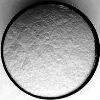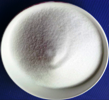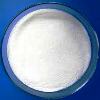|
|
Teappcm, is the several decades old manufacturer supplier exporter of High Purity Chemicals including Pharmaceutical Grade Excepients like IP BP JP USP Ph Eur FCC Food Grade ACS Reagent Grade of Chemicals in India USA UAE etc. It has several associated manufacturing facilities spread across the globe. Order quantities ranging from grams, killograms to container loads are given equal attention. The participating units have one or more of the certifications like Good Manufacturing Practice, Good Laboratory Practice, ISO-9001, ISO-22000, Halal & Kosher Cettification. We also have "REACH" Preregistration. |
Potassium Acetate, Calcium Acetate, Magnesium Acetate USP BP ACS Reagent FCC Food Grade Suppliers Exporters
Potassium Acetate BP
C2H3O2K -- 98.14 -- 127-08-2
DEFINITION
Potassium acetate contains not less than 99.0 per cent and not more than the equivalent of 101.0 per cent of C2H3KO2, calculated with reference to the dried substance.
CHARACTERS
A white, crystalline powder or colourless crystals, deliquescent, very soluble in water, freely soluble in alcohol.
IDENTIFICATION
A. It gives reaction of acetates.
B. It gives reaction of potassium.
TESTS
Solution S: Dissolve 10.0 g in distilled water and dilute to 100 ml with the same solvent.
Appearance of solution: Solution S is clear and colourless.
pH: Dissolve 1.0 g in carbon dioxide-free water and dilute to 20 ml with the same solvent. The pH of the solution is 7.5 to 9.0.
Reducing substances:
Dilute 10 ml of solution S to 100 ml with water. Add 5 ml of dilute sulphuric acid and 0.5 ml of a 0.32 g/l solution of potassium permanganate. Mix and boil gently for 5 min. The solution remains pink.
Chlorides:
Dilute 2.5 ml of solution S to 15 ml with water. The solution complies with the limit test for chlorides (200 ppm).
Sulphates:
Dilute 7.5 ml of solution S to 15 ml with distilled water. The solution complies with the limit test for sulphates (200 ppm).
Aluminium:
If intended for use in the manufacture of peritoneal dialysis solutions, haemofiltration solutions or hem dialysis solutions, it complies with the test for aluminium. Dissolve 2.0 g in 50 ml of water and add 5 ml of acetate buffer solution pH 6.0. The solution complies with the limit test for aluminium (1 ppm). Use as a reference solution a mixture of 1 ml of aluminium standard solution (2 ppm Al), 5 ml of acetate buffer solution pH 6.0 R and 49 ml of water. To prepare the blank use a mixture of 5 ml of acetate buffer solution pH 6.0 R and 50 ml of water.
Iron:
Dilute 5 ml of solution S to 10 ml with water. The solution complies with the limit test for iron (20 ppm).
Heavy metals:
Dissolve 5.0 g in water and dilute to 20 ml with the same solvent. 12 ml of the solution complies with limit test A for heavy metals (4 ppm). Prepare the standard using lead standard solution (1 ppm Pb).
Sodium:
Not more than 0.5 per cent of Na, determined by atomic emission
Loss on drying:
Not more than 3.0 per cent, determined on 1.000 g by drying in an oven at 100C to 105C.
Potassium Acetate USP
C2H3KO2 98.14
Acetic acid, potassium salt --- [127-08-2].
Potassium Acetate contains not less than 99.0 percent and not more than 100.5 percent of C2H3KO2, calculated on the dried basis.
Identification: A solution (1 in 10) responds to the tests for Potassium and for Acetate.
pH: between 7.5 and 8.5, in a solution (1 in 20).
Loss on drying: Dry it at 150 for 2 hours: it loses not more than 1.0% of its weight.
Heavy metals: the limit is 0.002%.
Limit of sodium: To pass the test not more than 0.03% of sodium is found.
Potassium Acetate ACS Analytical Reagent
CH3COOK
Formula Wt. 98.14
CAS Number 127-08-2
REQUIREMENTS
Assay: 99.0% CH3COOK
pH of a 5% solution:
6.5-9.0 at 25C
MAXIMUM ALLOWABLE
Insoluble matter: 0.005%
Chloride (Cl): 0.003%
Phosphate (PO4): 0.001%
Sulfate (SO4): 0.002%
Heavy metals (as Pb): 5 ppm
Iron (Fe): 5 ppm
Calcium (Ca): 0.005%
Magnesium (Mg): 0.002%
Sodium (Na): 0.03%
Calcium Acetate BP Ph Eur Grade
C4H6CaO4 --- 158.2 --- 62-54-4
DEFINITION
Calcium diacetate.
Content: 98.0 per cent to 102.0 per cent (anhydrous substance).
CHARACTERS
Appearance: White or almost white, hygroscopic powder.
Solubility: Freely soluble in water, slightly soluble in ethanol (96 per cent).
IDENTIFICATION
A. It gives reaction of calcium.
B. It gives reaction of acetates.
TESTS
pH: 7.2 to 8.2.
Readily oxidisable substances: Dissolve 2.0 g in boiling water and dilute to 100 ml with boiling water, add a few glass beads, 6 ml of 5 M sulphuric acid and 0.3 ml of 0.02 M potassium permanganate , mix, boil gently for 5 min and allow the precipitate to settle. The pink colour in the supernatant is not completely discharged.
Chlorides: Maximum 330 ppm.
Nitrates: Dissolve 1.0 g in water and dilute to 10 ml with the same solvent. Add 5 mg of sodium chloride, 0.05 ml of indigo carmine solution and add with stirring, 10 ml of nitrogen-free
sulphuric acid. The blue colour remains for at least 10 min.
Sulphates: Maximum 600 ppm.
Aluminium: Maximum 1 ppm.
Arsenic: Maximum 2 ppm.
Barium: Maximum 50.0 ppm.
Magnesium: Maximum 5.00 × 102 ppm.
Potassium: Maximum 0.10 per cent.
Sodium: Maximum 0.50 per cent.
Strontium: Maximum 5.00 × 102 ppm.
Heavy metals: Maximum 20 ppm.
Water: Maximum 7.0 per cent.
Calcium Acetate USP Grade
C4H6CaO4 158.17
Acetic acid, calcium salt ---
[62-54-4].
Calcium Acetate contains not less than 99.0 percent and not more than 100.5 percent of C4H6CaO4, calculated on the anhydrous basis.
Identification: A solution (1 in 20) responds to the tests for Calcium and for Acetate.
pH: 6.3 to 9.6, in a solution (1 in 20).
Water: not more than 7.0%, determined in a 0.7-g specimen.
Limit of fluoride: the limit is 0.005%.
Arsenic: 3 ppm.
Heavy metals: the limit is 0.0025%.
Lead: 0.001%.
Chloride: 0.05%.
Sulfate: 0.06%.
Limit of nitrate: To pass the test.
Limit of aluminum (where it is labeled as intended for parenteral use or for use in hemodialysis or peritoneal dialysis): To pass the test.
Barium (where it is labeled as intended for use in hemodialysis or peritoneal dialysis): the limit is 0.05%.
Limit of potassium (where it is labeled as intended for use in hemodialysis or peritoneal dialysis): the limit is 0.05%.
Limit of sodium (where it is labeled as intended for use in hemodialysis or peritoneal dialysis): the limit is 0.5%.
Limit of strontium (where it is labeled as intended for use in hemodialysis or peritoneal dialysis): the limit is 0.05%.
Readily oxidizable substances: Dissolve 2.0 g of it in 100 mL of boiling water, add a few glass beads, 6 mL of 10 N sulfuric acid, and 0.3 mL of 1 N potassium permanganate, mix, boil gently for 5 minutes, and allow the precipitate to settle: the pink color in the supernatant is not completely discharged.
Calcium Acetate FCC Food Grade
Ca(C2H3O2)2 Formula wt 158.17
INS: 263 CAS: [62-54-4]
DESCRIPTION
Calcium Acetate occurs as a fine, white, bulky powder. It is freely soluble in water and slightly soluble in alcohol.
Function: Buffer; stabilizer; firming agent.
REQUIREMENTS
Identification: A 1:10 aqueous solution gives positive tests for Calcium and for Acetate.
Assay: Not less than 99.0% and not more than 100.5% of Ca(C2H3O2)2, calculated on the anhydrous basis.
Chloride: Not more than 0.05%.
Fluoride: Not more than 0.005%.
Lead: Not more than 2 mg/kg.
Sulfate: Not more than 0.1%.
Water: Not more than 7.0%.
Magnesium Acetate Tetrahydrate BP
Mg(CH3COO)2-4H2O -- 214.5 -- 16674-78-5
DEFINITION
Content:
98.0 per cent to 101.0 per cent of magnesium acetate (anhydrous substance).
CHARACTERS
Appearance:
Colourless crystals or white, crystalline powder.
Solubility:
Freely soluble in water and in alcohol.
IDENTIFICATION
A. Dissolve about 100 mg in 2 ml of water. Add 1 ml of dilute ammonia and heat. A white precipitate is formed that dissolves slowly on addition of 5 ml of ammonium chloride solution. Add 1 ml of disodium hydrogen phosphate solution. A white crystalline precipitate is formed.
B. It gives reaction of acetates.
TESTS
pH: 7.5 to 8.5.
Dissolve 2.5 g in carbon dioxide-free water and dilute to 50 ml with the same solvent.
Chlorides: Maximum 330 ppm.
Nitrates: Maximum 3 ppm.
Sulphates: Maximum 600 ppm.
Aluminium: Maximum 1 ppm.
Calcium: Maximum 100 ppm.
Potassium: Maximum 0.1 per cent.
Sodium: Maximum 0.5 per cent.
Heavy metals: Maximum 40 ppm.
Readily oxidizable substances: Dissolve 2.0 g in 100 ml of boiling water, add 6 ml of a 150 g/l solution of sulphuric acid and 0.3 ml of 0.02 M potassium permanganate. Mix and boil gently for 5 min. The pink colour is not completely discharged.
Water: 33.0 per cent to 35.0 per cent, determined on 0.100 g.
Magnesium Acetate Tetrahydrate ACS Reagent
(CH3COO)2Mg . 4H2O
Formula Wt 214.46
CAS Number 16674-78-5
REQUIREMENTS
Assay: 98.0-102.0% (CH3CO2)2Mg . 4H2O
MAXIMUM ALLOWABLE
Insoluble matter: 0.005%
Chloride (Cl): 0.001%
Nitrogen compounds (as N): 0.001%
Sulfate (SO4): 0.005%
Barium (Ba): 0.001%
Calcium (Ca): 0.01%
Manganese (Mn): 0.001%
Potassium (K): 0.005%
Sodium (Na): 0.005%
Strontium (Sr): 0.005%
Heavy metals (as Pb): 5 ppm
Iron (Fe): 5 ppm



Please contact us for Further Information and Potassium Acetate, Calcium Acetate, Magnesium Acetate Supplier's Safety Data Sheet.
Potassium Acetate, Calcium Acetate, Magnesium Acetate Suppliers:
Teappcm
TEL: 91-22-23770100, 23774610, 23723564. FAX: 91-22-23728264.
Email: anmol@pcmenergy.com
Barter
They who love thee on this earth, keep calling on thee and chanting thy beads
Lest thou forgetest.
They assign the credit of their hard work to your blessings
They keep you amused.
They come to thy temple with baskets of fruits, as if you were a glutton
They deny the same to their children.
They offer you milk for a bath and burn the ghee
They hardly understand the meaning of it.
They bring gold and diamonds. They come with beating of drums
They love to advertise their offerings.
They offer you a small bribe as advance for booty, called lottery
They love to dream.
I do not bow down at your door
I do not bargain for booty
Your promise of the heaven does not lure me
Your hell-fire does not scare me
I do not even know the proper method of prayer
I do not offer any thing to you
Ages have gone by and I have not seen you my lord
Yet my love for you keeps waiting for you
We are exporters to USA, Canada, UAE, Europe, South Africa, Tanzania, Kenya, Nigeria, Egypt, Uganda, Turkey, Mexico, Brazil, Chile, Argentina, Dubai, Sweden, Finland, Norway, Netherlands, Denmark Greenland, Norway, UK, Ireland, Germany, Belgium, Switzerland, Czech Rep., Slovakia, Scotland, Poland, Belarus, Germany, Austria, France, Ukraine, Australia, Spain, Italy, Vietnam, Thailand, etc.